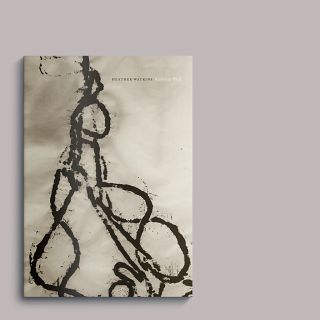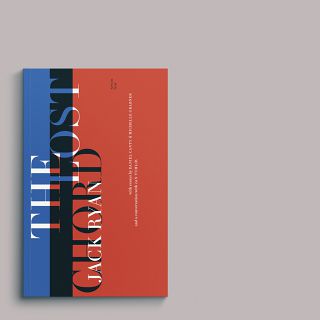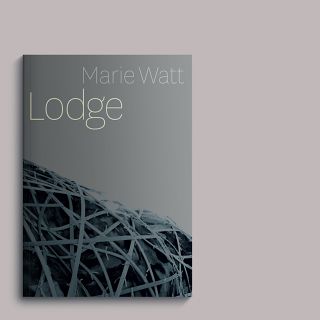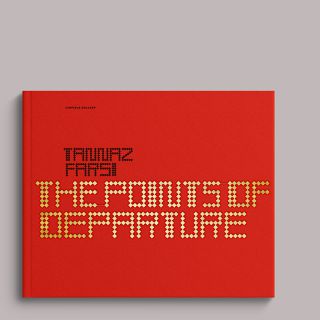Half-life
Works
- 2005
- Books / editorial
- Triangular Press
- Half-life
Barbara Tetenbaum’s primary medium is the Vandercook SP-15 proofing press. Like many book artists, she uses type and old advertising cuts in her work, but she also integrates linoleum blocks, telephone wire, and other printing artifacts: anything that can be made type-high is fair game. Her approach to bookmaking happens on press; she may begin with a rough idea but improvises freely once the paper begins feeding through. The process has more in common with painting than printmaking, and the resulting pages are host to many different voices.
We hoped to borrow some of that energy in preparing a catalog for her midcareer retrospective. Half-Life contains four parallel and overlapping narratives: an illustrated chronology of Tetenbaum’s career; an interpretive essay, in English and German, from one of the European book arts community’s most respected critics and practitioners; multiple views of each of the thirty-six books in the exhibition; and an annotated catalog of advertising cuts from Tetenbaum’s working collection—all tucked comfortably, along with nine full-size page reproductions, into forty-eight pages.
The book does not stand on ceremony. It contains all of the elements of a traditional catalog, and proceeds according to chronology. But the underlying structure, while worked-out and coherent, encourages intermingling among the four narrative strands and reveals Tetenbaum’s work in a way that is true to her spirit—serious and wry, mechanical and visceral—without aping her form.
Illustrations
1.
Cover

Although the book’s interior was printed in six colors, its cover was humble, unfinished binder’s board, quarter-bound in cloth, with tipped-on cover and spine labels. These Tetenbaum printed on waste sheets from her studio, so that each copy would be unique. In broad terms, the cover was meant as a deconstruction of the bookmaking process, revealing the book’s component parts and hinting at the structure within.
2.
Frontispiece

The first nine pages of Half-Life feature pages from the artist’s most recent title at the time, Gymnopædia No. 4, reproduced actual size, to give the reader an idea of the level of texture and detail in her work.
3.
Frontispiece, continued

Gymnopædia No. 4 is also a “piece for four hands”; these pages helped to set up the four-column motif we used to organize the book’s text . . .
4.
Full title

. . . wherein the four simultaneous narratives of the books are defined. The background is a detail of a linocut, and a motif that reoccurs in Tetenbaum’s work: mark-making as a method of keeping record.
5.
Curator’s introduction

The artist, shown in a large, tradesman-like portrait upon which the curator Jim Carmin’s notes are set in an orderly field of flat, neutral color.
6.
Essay

The book is composed of four simultaneous narratives. From left: an illustrated timeline of the artist’s life and work; a critical essay, in English and German, from the Leipzig artist and critic Ute Schneider; illustrations of all of the books included in the exhibition; and a selection of old advertising cuts from Tetenbaum’s collection, which figure prominently in her work.
7.
Essay, continued

Given the large number of parts to be included within forty-eight pages, the curatorial section of Half-Life was an exercise in compression. It was here that presenting the content as four concurrent threads was most useful: we couldn’t afford to be precious. Once the planning had been done, we had to get over ourselves and let the content fend for itself.
For example: images, though placed according to a set of rules, were free to intrude into neighboring areas, as necessary; and as it happened, they did. Books are shown in relative scale, and the accordion-folded work in particular would often stretch into and cover the catalog of advertising cuts in the right column.
8.
Essay, continued

Entries in the advertising-cuts column wrap from one page to the next—a leftover from our original production spec (digital printing on one side of a 12×18 sheet; French-folding the result). But we found that even without the physical link of a French fold, the images supported continuity and created an organic frame for the otherwise rationally constructed page. We printed the cuts themselves in the orange-red of the European craft tradition.
9.
Notes

Curatorial pages wrap up with technical notes regarding Tetenbaum’s process and endnotes for the essay. At right, illustrations of some of Tetenbaum’s installation work.
10.
Custodial material

Toward the back of the book, we modulated the underlying grid into four even columns to handle more homogenous content types.
Colophon
48pp. + cover
7⅝ × 10⅝ in., ed. 1,000
Printed offset in six colors (4c + 2 match) on coated matte paper
Sewn and quarter-bound in cloth over 4–ply binder’s board with tipped-on letterpress cover and spine labels
Composed in Paperback, ITC Bodoni, and Benton Sans
- Writers
- Jim Carmin (introduction)
Uta Schneider (essay)
Barbara Tetenbaum - Printing
- Dynagraphics




